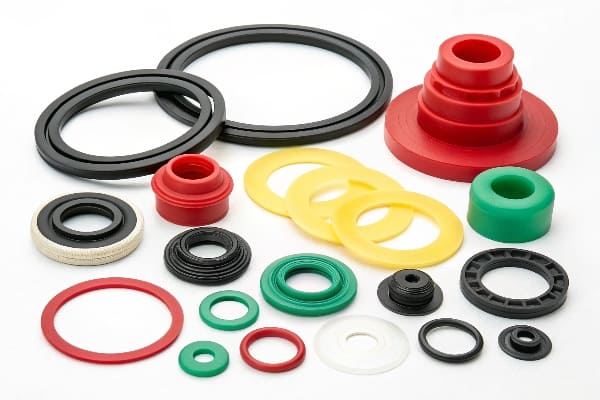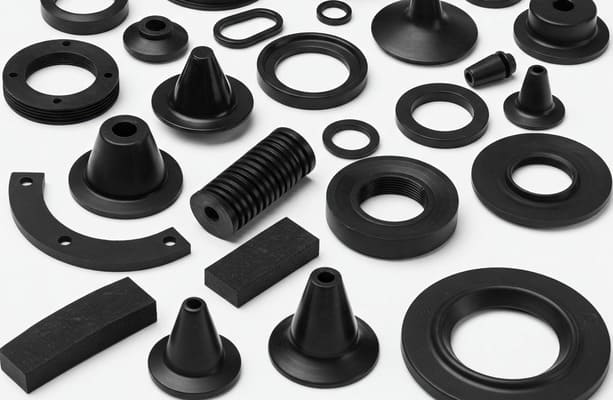Have you ever wondered if rubber will eventually be replaced by an alternative material? Rubber is a critical component in many industries, from automotive to medical devices, but as technology advances, the idea of replacing rubber with something else is a topic worth exploring.
While there are alternative materials to rubber in certain applications, it’s unlikely that rubber will ever be fully replaced due to its unique properties like elasticity, flexibility, and resilience. However, alternative materials may complement or partially replace rubber in specific industries or applications.

Let’s explore the possibility of replacing rubber with alternatives, what these alternatives are, and how they compare to rubber in terms of performance and sustainability.
Why Is Rubber So Difficult to Replace?
Rubber’s unique combination of elasticity1, durability, and flexibility makes it hard to replace in many applications.
Rubber is a natural and synthetic polymer that is extremely versatile. It can stretch, return to its original shape, resist wear, and absorb shocks. These qualities make rubber essential in products like tires, seals, and medical equipment, where flexibility and durability are critical.
Key Properties of Rubber ✅
| Property | Benefit |
|---|---|
| Elasticity | Allows stretching and recovery |
| Durability | High resistance to wear and tear |
| Flexibility | Works in extreme conditions |
| Shock Absorption | Ideal for protective components |
| Chemical Resistance | Withstands exposure to oils and fuels |
These properties make rubber indispensable in many industries, and no single alternative currently offers the same combination of benefits.
What Are the Alternatives to Rubber?
Although rubber is widely used, several materials are being explored as potential alternatives in specific applications.
Some alternatives to rubber include plastics, thermoplastic elastomers (TPE), silicones, and composite materials. These materials often aim to replicate rubber’s performance while offering additional benefits such as lower cost, lighter weight, or higher resistance to certain environmental conditions.
Common Alternatives to Rubber ✅
| Alternative Material | Benefits | Common Uses |
|---|---|---|
| Plastics | Lower cost, easy processing | Packaging, consumer goods |
| TPE (Thermoplastic Elastomers)2 | Flexibility, recyclability | Automotive, seals |
| Silicone | High-temperature resistance | Medical devices, kitchenware |
| Composite Materials | High strength, lightweight | Automotive, industrial parts |
While these materials offer various advantages, they are not a perfect substitute for rubber in every case.
Will Rubber Be Replaced by a Single Material?
It’s unlikely that a single material will completely replace rubber across all industries.
Rubber is unmatched in terms of its ability to offer both flexibility and durability, making it the material of choice for applications requiring these qualities. While alternatives can perform well in specific applications, no single material can match the full range of rubber’s unique properties.

Why No Single Material Can Replace Rubber ✅
| Material | Limitation | Best Use |
|---|---|---|
| Plastics | Limited elasticity and flexibility | Packaging, insulation |
| TPE | May not offer the same high wear resistance as rubber | Seals, gaskets |
| Silicone | Higher cost, limited elasticity | High-temperature applications |
| Composite Materials | Less flexibility than rubber | Structural parts, heavy-duty uses |
Instead of a single replacement, the future may see a combination of materials working together to perform specific tasks while taking advantage of each material's strengths.
How Are Companies Working to Improve Rubber Alternatives?
Innovation in material science continues to bring new alternatives to rubber, but the focus is often on enhancing the performance of these materials to compete with rubber’s unique capabilities.
Companies are working on developing new types of plastics, TPEs, and composites that offer improved properties such as better elasticity, higher durability, or increased resistance to temperature and chemicals. Some research is also focused on developing bio-based rubbers3 and recycled rubber4 to improve sustainability.
Innovations in Rubber Alternatives ✅
| Innovation | Benefits | Examples |
|---|---|---|
| Bio-based Plastics | Reduced environmental impact | Bio-PET, PLA |
| Recycled Rubber | More sustainable production | Recycled rubber in tires |
| Advanced TPEs | Better elasticity and strength | Automotive gaskets, seals |
These innovations may allow for more sustainable or specialized alternatives to rubber, but they are unlikely to replace rubber entirely.
What Are the Challenges in Replacing Rubber?
There are several challenges when trying to replace rubber with alternatives in critical applications.
Rubber’s versatility and unique properties make it difficult to fully replace in many industries. For example, tire manufacturers rely heavily on rubber’s elasticity and durability, and while synthetic rubber can be altered for better performance, no current material offers the same combination of attributes. Additionally, alternatives often struggle to match rubber's environmental adaptability.
Challenges in Replacing Rubber ✅
| Challenge | Impact |
|---|---|
| Versatility | No alternative matches rubber’s broad use cases |
| Performance | Alternatives may not offer the same durability or elasticity |
| Cost | Many alternatives are more expensive than rubber |
These challenges highlight why rubber will continue to be the material of choice in many industries for the foreseeable future.
Conclusion
While there are promising alternatives to rubber, it’s unlikely that a single material will completely replace rubber in all its applications. Rubber's unique combination of elasticity, durability, and performance in extreme conditions makes it indispensable across many industries. However, the development of new materials and innovative rubber substitutes will likely continue to complement rubber, especially in areas where sustainability and cost-efficiency are key concerns.
🚀 Need High-Quality Rubber Solutions for Your Industry?
Contact Julong Rubber today or Request a Custom Quote for tailored rubber products that meet your needs!
Understanding elasticity can help you appreciate why rubber is so unique and difficult to replace in various applications. ↩
Exploring TPE can reveal innovative alternatives to rubber that may suit specific needs in various industries. ↩
Explore the potential of bio-based rubbers for sustainable applications and their advantages over traditional materials. ↩
Discover the environmental benefits and applications of recycled rubber, contributing to sustainability in production. ↩






